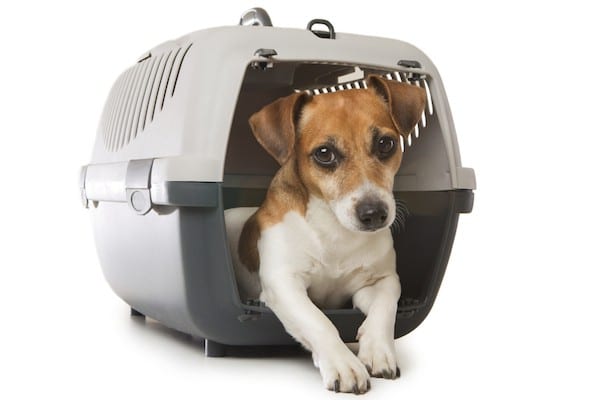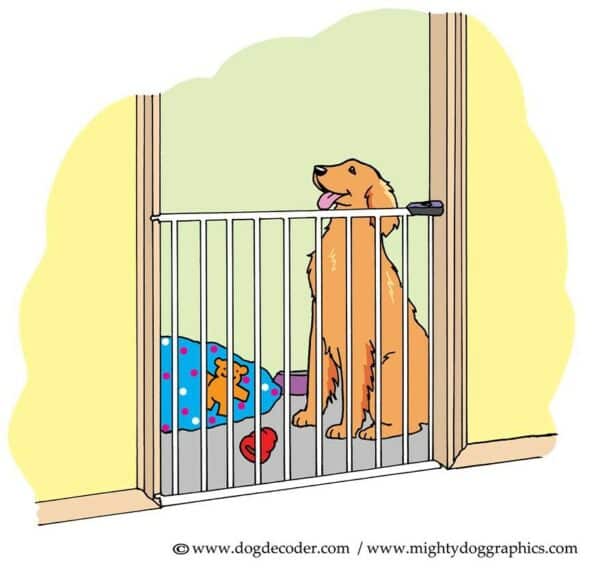Who said dogs are den animals, anyway?
Den animals include foxes, moles, raccoons, bears, and bobcats. Dogs are not den animals.
If they were den animals, why then would we have to teach them to use and like a crate? Simply because they aren’t — period.
While dogs do like to find places away from commotion at times, this is not the same as instinctively needing to go into a den. They simply want to find a peaceful place to rest, much like I do when I’m at a gathering and it’s too hectic, so I go outside for fresh air and quiet.

Napping Frenchie by Shutterstock.
Dog training has evolved for the better in myriad ways. However, anything that evolves without critical thought can go awry.
Crate training can be a necessary training tool, yet it need not be a lifestyle. A crate can also be very damaging to the psyche of a growing puppy or an adult dog if they haven’t been properly trained with one.
In his Handbook of Applied Dog Behavior and Training, Steven Lindsay states that while:
The role of crate confinement in the etiology of behavior problems has not been scientifically established […] empirical impressions and logic dictate that it probably plays an important role in the development or exacerbation of many adjustment problems.
He argues that:
The widespread practice of routinely caging a dog at night and then again during the day for periods totaling 16 to 18 hours (or more) is an extremely problematic practice that should not be condoned or encouraged because it probably underlies the development of many adjustment problems, including aggression.
The purpose of crate training, he says:
…should be to get the dog out of the crate as soon as possible, and to use the crate as little as possible in the service of training and space-management objectives.
I’m going to use the word cage here instead of crate because that’s what it is. A crate is just a less harsh name for a cage. When did we as a culture become comfortable with putting dogs in cages? Why haven’t we questioned this, but instead made it the new normal? I never heard of this type of training growing up. We used puppy gates to confine dogs to a certain room only for puppyhood, while gradually opening up the house as the puppy aged.
Let’s talk about this paradigm shift toward cage training. Cage training actually began when both parents began working, leaving no one at home to raise the puppy. Today, if a family wants a dog but no one stays home during the day, then what? Do families go without a dog? Hopefully not. Yet, the cage misuse is definitely wreaking havoc on many dogs, causing problems for the entire family, including when the “problem dog” ends up in a shelter to be re-homed again and again or worse, euthanized. How can puppies learn to be well socialized with good house manners if they are locked up during dinner or every time company arrives?
Dog parks, doggie day care, dog walkers, and even dog trainers are on the rise because of this single yet monumental cultural shift in raising the family dog. These options, thankfully, have become a way out of the crate because somewhere deep inside we know that dogs can’t be happy spending hours on end in a cage.
A crate used properly and timely can be helpful as a training tool, but not something they spend hours on end in. It’s not healthy for them mentally or physically to crunch up their bodies, especially while the family enjoys together time. Dogs are social animals. After all, don’t we get dogs to be a part of the family?

Jack Russell Terrier in crate by Shutterstock.
I have never used a crate for training. Not in 38 years as a professional trainer. I did use a crate when I moved to France in the mid-’70s because I brought my Labrador, Charlie, with me. He had never seen a crate, but I knew he would need to be in one for the flight. I spent the month before our departure getting him used to it. No problem. He traveled in it, and we never saw it again — I think I actually left it at the airport.
I often hear the pro-crate argument that a dog feels safe in one, just like a wolf den. To be clear, a wolf is also not a den animal. They do use maternal dens when giving birth and rearing their young for protection, but they live in the open, starting at around 10 weeks of age, which is just about the time we are putting puppies in cages.
While I understand the argument that a dog needs to feel safe, I know that they can feel safe on the couch, in another room, under the table, on their bed, etc. They can feel safe outside of a cage, too. I want to make the point again and very clearly that since they are not den animals, crate training is not synonymous with puppy training — it’s not mandatory.
Another argument I hear is that a dog should feel comfortable in a crate in case of emergency. OK, well if it’s an emergency and you’re piling the entire family into the car, is there going to be room for a crate? What if the car isn’t available because a tree fell on it and you’re off on foot? You get my gist. A puppy raised right will feel safe with you no matter what situation arises.

Happy dog behind pet gate. (Illustration by Denise O’Moore/Mighty Dog Graphics)
If you meet your pup’s needs with physical exercise and proper training, you can teach your pup to be alone in your home without causing destruction and without feeling separation anxiety. You can have peace of mind, knowing that your dog will feel safe and secure at home while you’re away.
I know that there will be very intense reactions to this column — please know that this is not about judging anyone for their choices, but instead about thinking critically about the use of crates. There are other ways to raise a puppy, and you can choose them.
About the author: Jill Breitner is a professional dog trainer and dog body language expert, loving life with friends and family. She is a member of the Pet Professional Guild and is the author of Dog Decoder, a smartphone app about dog body language. Join Jill on her Dog Decoder Facebook page.
The post Why I Don’t Believe in Crate Training appeared first on Dogster.
No comments:
Post a Comment